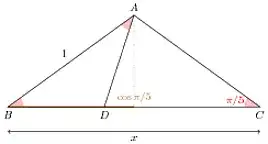You could continue on the track you've shown. You've got $\cos(\pi/5)=1-2\cos^2(2\pi/5)$, so $2\cos^2(2\pi/5)+\cos(\pi/5)-1=0$, and since $\cos(2\pi/5)=2\cos^2(\pi/5)-1$, then $8\cos^4(\pi/5)-8\cos^2(\pi/5)+\cos(\pi/5)+1=0$, so $\cos(\pi/5)$ is a root of $8x^4-8x^2+x+1$. In particular, it is a positive root. Some inspection of that polynomial shows that it has 1/2 and -1 as rational roots, and $\cos(\pi/5)$ can't be either of those (as $\cos(\pi/5)>\cos(\pi/3)=1/2$). Factoring those out leaves $4x^2-2x+1$, and the positive root of that one is $\phi/2$.
Of course, if you realize that $\phi/2$ is the unique positive root of $4x^2-2x+1$ and that $\cos(\pi/5)$ is positive, then you only need to check that $\cos(\pi/5)$ is a zero of $f(x)=4x^2-2x+1$. Here's one slick way to do that:
Let $x=\cos(\pi/5)$, and use the identity $2\cos^2\theta=\cos(2\theta)+1$ to give you $f(x)=2\cos(2\pi/5)-2\cos(\pi/5)+1$. As you've already noted, $\cos(\pi/5)=-\cos(4\pi/5)$, so that means $f(x)=2\cos(4\pi/5)+2\cos(2\pi/5)+1$. Now,
$$\begin{eqnarray*}
f(x) & = & 1+\cos(2\pi/5)+\cos(4\pi/5)+\cos(-4\pi/5)+\cos(-2\pi/5)\\
& = & 1 + \cos(2\pi/5)+\cos(4\pi/5)+\cos(6\pi/5)+\cos(8\pi/5)\\
& = & \sum_{k=0}^4\cos(2k\pi/5)
\end{eqnarray*}$$
Consider how the angles $2k\pi/5$ for $k=0,..,4$ are evenly spaced about the unit circle. If you set 5 equal weights at those spots on the edge of an ideal weightless disk (or any ideal disk perfectly balanced on a point at its center), the system of weights would be perfectly balanced on the point at the center of the disk. The same is then true if you were to balance the disk along any line through the disk's center, and in particular, the line corresponding to the $y$-axis. The law of the lever says that means the total signed distances of those weights from that line--that is, the sum of the cosines of those angles--is precisely 0. That is, $f(x)=0$.
Working with complex numbers, we can use a similar approach with much less work, but if you're unfamiliar with them, that won't help at all.
